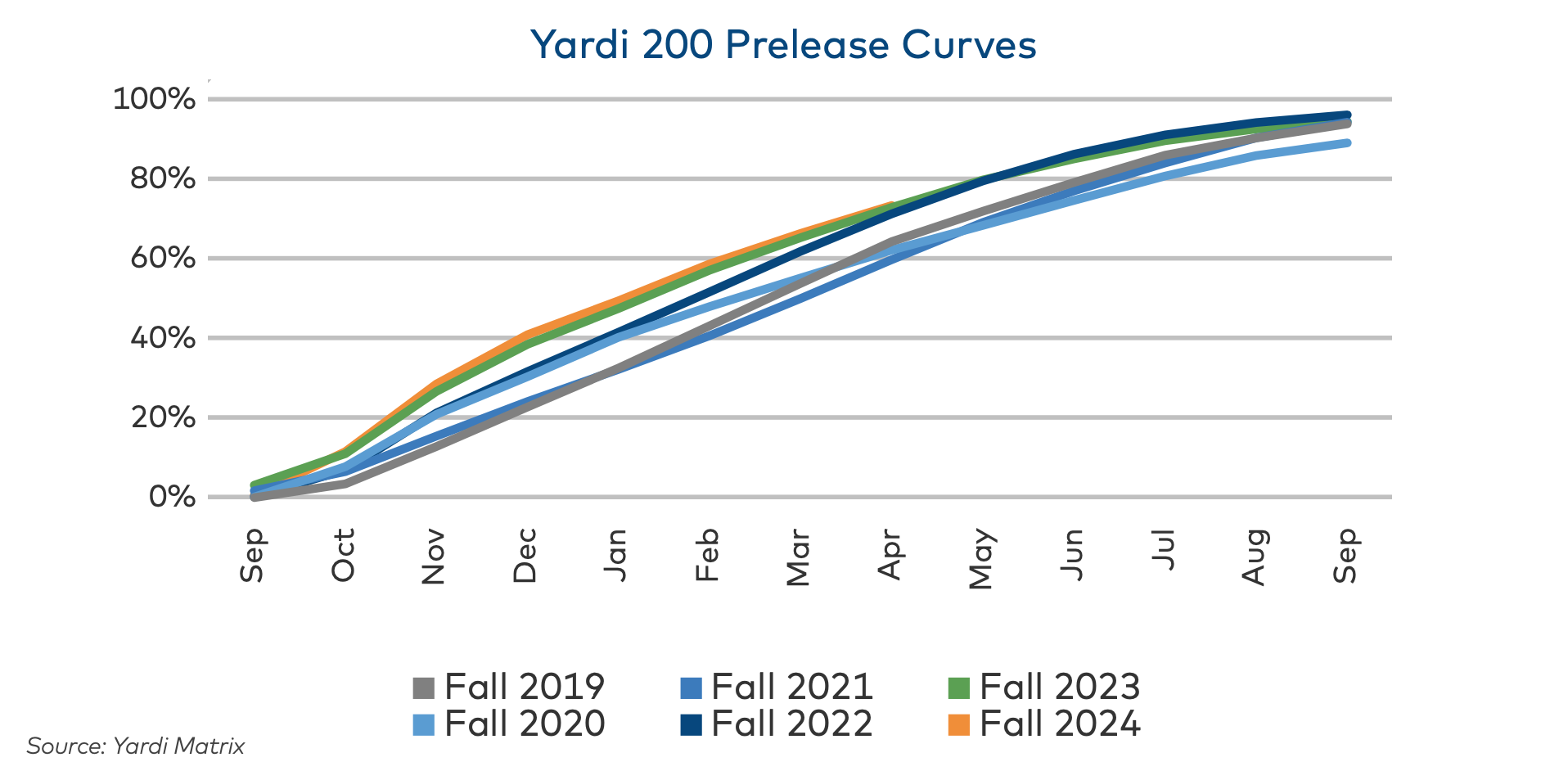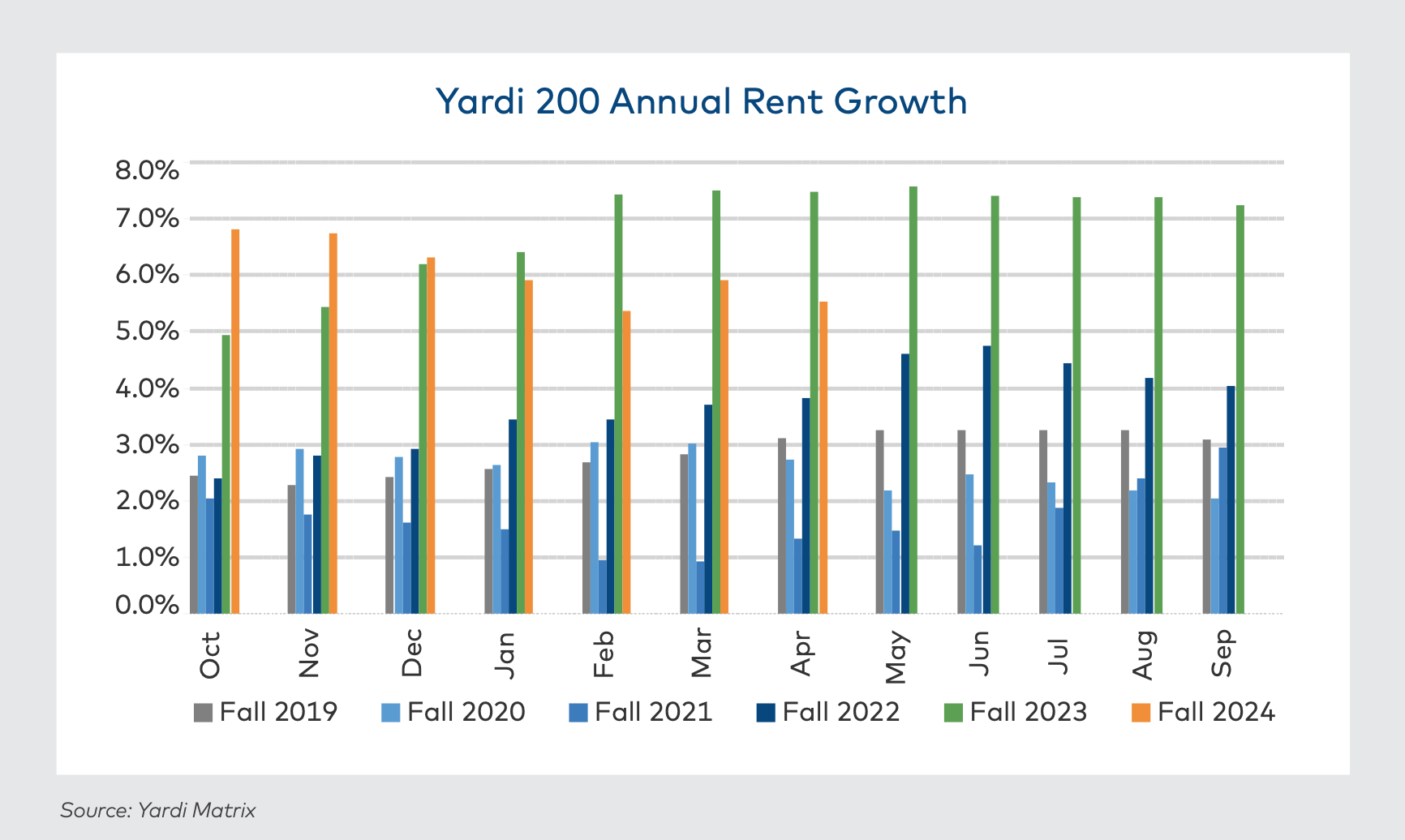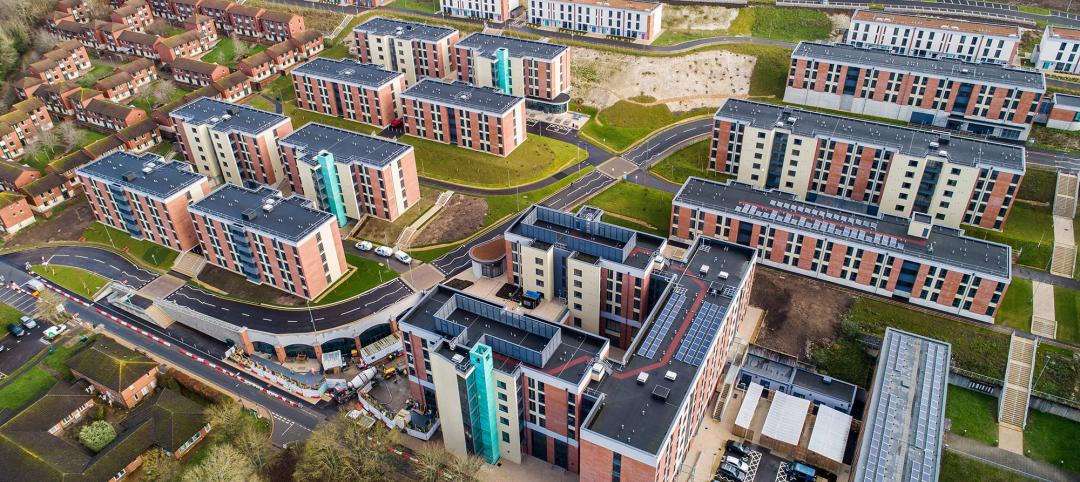Preleasing for the 2024–2025 student housing season reached 73.5% in April, 50 basis points year-over-year (YOY). Although the pace has slowed down this year, preleasing has started earlier each year, outpacing typical pre-pandemic trends. That is according to the May 2024 Matrix Student Housing National Report.
Yardi Matrix Student Housing Preleasing Trends
Some operators note that a delay in FAFSA processing has impacted the sector, slowing down preleasing paces. Regardless, preleasing is up 10% or more YOY in 34 markets.

“With the leasing season one of the best yet, the tone at the recent Interface Student Housing Conference was very positive,” the report states. “At 73.5% in April, preleasing was similar to last year’s record pace, while rent growth moderated to 5.5% but remained well above average for the sector and for commercial real estate overall.”
Top 10 Universities With the Most Year-over-Year Growth in Percentage Preleased
- Central Michigan, Mount Pleasant, Mich. (23.5% growth in percentage preleased)
- Bowling Green State, Bowling Green, Ohio (19.7%)
- Ohio University, Athens, Ohio (19.3%)
- University of California – Riverside, Riverside, Calif. (18.7%)
- University of Kansas, Lawrence, Kan. (17.7%)
- University of Missouri, Columbia, Mo. (16.7%)
- San Diego State, San Diego, Calif. (16.4%)
- Southern California, Los Angeles, Calif. (15.7%)
- University of Nebraska, Lincoln, Neb. (14.2%)
- Temple University, Philadelphia, Pa. (14.1%)
Some schools have nearly preleased all of their beds, with 19 schools over 90% preleased in May 2024. Ole Miss is completely preleased, while Kentucky, Purdue, and James Madison are at around 93 percent.
Meanwhile, 37 markets are more than 10% behind last year’s pace for preleasing. This includes Buffalo (23% behind the 94.8% preleasing rate in April 2023), Arizona State (19% behind), and Wisconsin (10%).
RELATED
- March student housing preleasing in line with last year
- October had fastest start ever for student housing preleasing
- Student Quarters selected to manage 502-bed student housing community
Rent Growth Trends May 2024
Rent growth for May 2024 slowed as well but remains relatively strong. The average student housing rent rose 5.5% year-over-year in April, to $895 per bed. Though growth has slowed from the early stages of the leasing season, it remains near the 2024–2025 average of 6 percent.

Schools with declining rents include many that failed to reach 90% occupancy in Fall 2023, according to the Matrix report. This includes Washington State which had 81% occupancy and a rent drop of 8%, Southern California (84% occupancy, 6% rent decline), and Nevada-Reno (84% occupancy, 3% rent decline).
Universities like Tennessee lead the student housing market in terms of rent growth. Tennessee has rents up nearly 18% YOY in April, followed by Clemson (17%), Ohio State (15%), and North Texas (15%).
Related Stories
MFPRO+ News | Oct 6, 2023
Announcing MultifamilyPro+
BD+C has served the multifamily design and construction sector for more than 60 years, and now we're introducing a central hub within BDCnetwork.com for all things multifamily.
Contractors | Sep 25, 2023
Balfour Beatty expands its operations in Tampa Bay, Fla.
Balfour Beatty is expanding its leading construction operations into the Tampa Bay area offering specialized and expert services to deliver premier projects along Florida’s Gulf Coast.
Affordable Housing | Sep 25, 2023
3 affordable housing projects that serve as social catalysts
Trish Donnally, Associate Principal, Perkins Eastman, shares insights from three transformative affordable housing projects.
MFPRO+ Blog | Sep 21, 2023
The benefits of strategic multifamily housing repositioning
With the rapid increase in new multifamily housing developments, owners of existing assets face increasing competition. As their assets age and the number of new developments increases seemingly day-by-day, developers will inevitably have to find a way to stay relevant.
Multifamily Housing | Jul 31, 2023
6 multifamily housing projects win 2023 LEED Homes Awards
The 2023 LEED Homes Awards winners in the multifamily space represent green, LEED-certified buildings designed to provide clean indoor air and reduced energy consumption.
Adaptive Reuse | Jul 27, 2023
Number of U.S. adaptive reuse projects jumps to 122,000 from 77,000
The number of adaptive reuse projects in the pipeline grew to a record 122,000 in 2023 from 77,000 registered last year, according to RentCafe’s annual Adaptive Reuse Report. Of the 122,000 apartments currently undergoing conversion, 45,000 are the result of office repurposing, representing 37% of the total, followed by hotels (23% of future projects).
Multifamily Housing | Jul 13, 2023
Walkable neighborhoods encourage stronger sense of community
Adults who live in walkable neighborhoods are more likely to interact with their neighbors and have a stronger sense of community than people who live in car-dependent communities, according to a report by the Herbert Wertheim School of Public Health and Human Longevity Science at University of California San Diego.
Urban Planning | Jun 15, 2023
Arizona limits housing projects in Phoenix area over groundwater supply concerns
Arizona will no longer grant certifications for new residential developments in Phoenix, it’s largest city, due to concerns over groundwater supply. The announcement indicates that the Phoenix area, currently the nation’s fastest-growing region in terms of population growth, will not be able to sustain its rapid growth because of limited freshwater resources.
Student Housing | Jun 5, 2023
The power of student engagement: How on-campus student housing can increase enrollment
Studies have confirmed that students are more likely to graduate when they live on campus, particularly when the on-campus experience encourages student learning and engagement, writes Design Collaborative's Nathan Woods, AIA.
Urban Planning | Jun 2, 2023
Designing a pedestrian-focused city in downtown Phoenix
What makes a city walkable? Shepley Bulfinch's Omar Bailey, AIA, LEED AP, NOMA, believes pedestrian focused cities benefit most when they're not only easy to navigate, but also create spaces where people can live, work, and play.


















